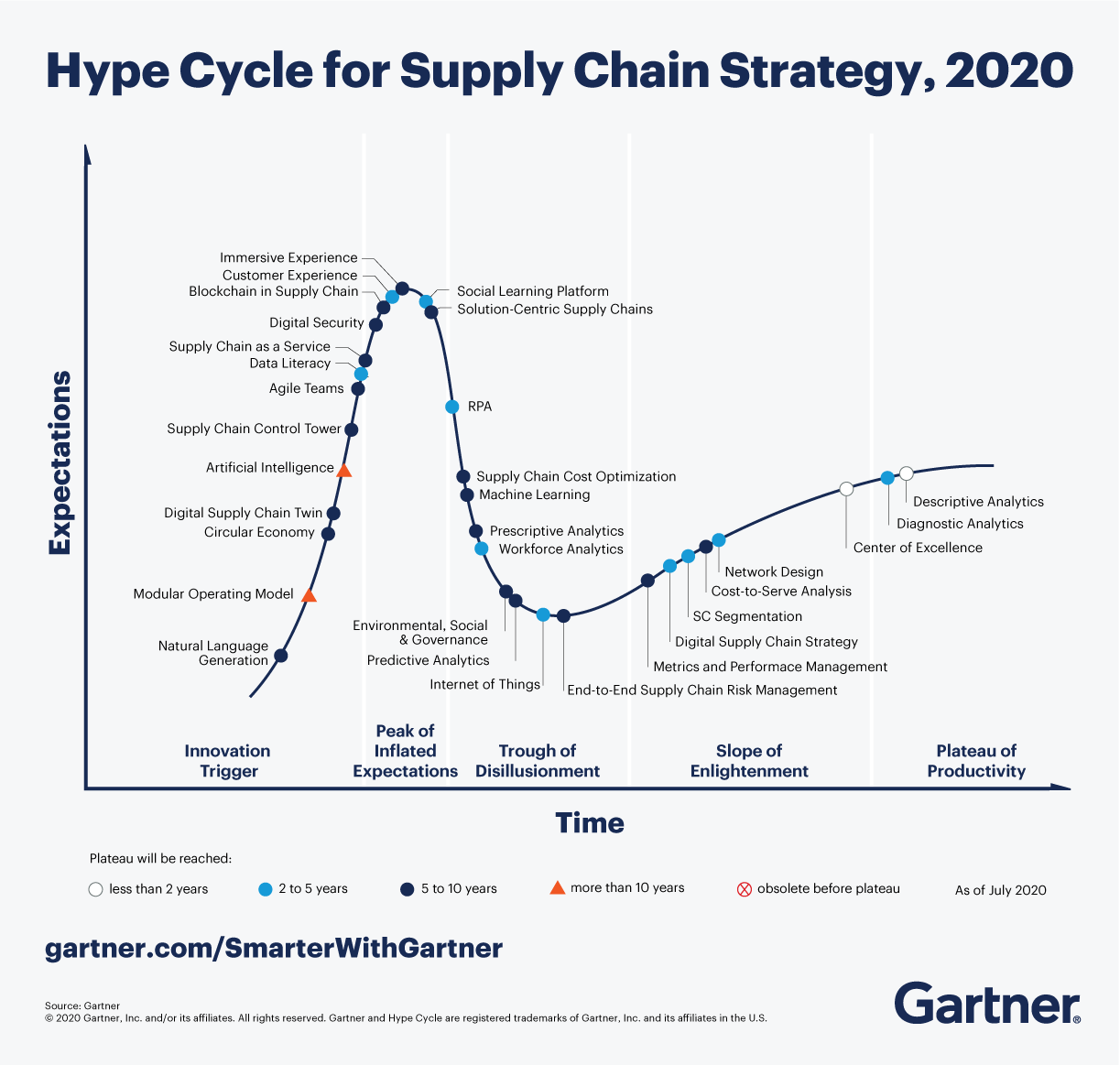Supply chain leaders can evaluate the capabilities from this Hype Cycle to make strategic decisions on pilot projects and investments.
In this year of uncertainty and disruption, supply chain leaders must strive to balance a focus on foundational capabilities with the pursuit of innovation. Organizations that set the base for their success now will be able to pivot out of the economic downturn much faster than their competitors.
“A Gartner Hype Cycle is an excellent way for supply chain leaders to figure out what actions to take next, where to invest now and what to keep on the radar,” says Noha Tohamy, Distinguished VP Analyst, Gartner. “Some of the capabilities are very close to maturity, while others such as artificial intelligence (AI) are still evolving. Nevertheless, leaders must realize their potential for business transformation and start active exploration and experimentation.”
In the Gartner Hype Cycle for Supply Chain Strategy, 2020, there are a healthy number of capabilities to the left of the peak, which reflect the many emerging capabilities that supply chain organizations are exploring. On the right are the capabilities that companies should be actively adopting at scale to optimize their performance.
Here are five capabilities from the Gartner Hype Cycle for Supply Chain Strategy, 2020 that supply chain leaders should have on their radar.
Artificial intelligence (AI)
Artificial intelligence (AI) still resides at the beginning of the Hype Cycle and it will be another decade until it reaches maturity. However, its impact will be transformational because it supports an organization’s vision for broader supply chain automation.
In the last year, AI adoption has progressed significantly due to better awareness, an expanded vision of supply chain automation and the growing availability of supply-chain-specific AI solutions. Early adopters report promising benefits, yet are slow to embark on broader AI projects.
Supply chain leaders should start experimenting with the technology, but with a clear focus on the use cases that present the highest potential. It’s also important to think about any cultural changes that might come with further AI adoption and train users to incorporate AI into their decision-making processes.
Immersive experience
The concept of immersive experience describes the blending of the digital and physical worlds to create an enhanced experience. It is a combination of conversational systems and augmented virtual or mixed reality and is currently located right at the top of the Hype Cycle.
While some industries — especially the medical and military sectors — already explore immersive experience capabilities, most businesses still consider the concept a novelty. As the cost and performance of hardware improves, however, adoption will increase. Over time, new solutions will emerge that provide capabilities not currently available and accelerate adoption.
Internet of things (IoT)
The internet of things (IoT) has slid to the very bottom of the Hype Cycle — into the Trough of Disillusionment. Many companies have implemented the technology in some form, but they struggle to define the best opportunities for using its measurement and tracking capabilities.
Still, there is a lot of potential to grow its use over the next several years. Gartner estimates that installed IoT endpoints for manufacturing and natural resources industries will grow to 1.9 billion units in 2028. That is five times the 331.5 million units installed in 2018.
For supply chain leaders who want to implement or expand IoT capabilities, it’s important to work with subject matter experts to identify supply chain processes that can benefit from IoT, as processes will have to be redesigned in some cases to accommodate IoT capabilities.
Digital supply chain strategy
A digital supply chain strategy prepares the supply chain to create a short- and long-term vision that aligns stakeholders behind an integrated set of principles as well as digitally enabled capabilities and investments. The strategy defines a supply chain digital roadmap that supports the ambitions of the enterprise while balancing both transformation and optimization initiatives.
“82% of executives have a management initiative or transformation program underway”.
At the moment, digital supply chain strategy is moving up the curve. According to a recent Gartner survey, 82% of executives have a management initiative or transformation program underway to make the business more digital, and nearly half of supply chain organizations have actively begun to define, are implementing, or have already implemented a digital supply chain roadmap.
Descriptive analytics
Descriptive analytics is the application of logic, pattern detection, and discovery, and business rules to data. It helps organizations understand what is currently happening or has happened for example, via a supply chain visibility solution.
This capability has almost reached the end of the Hype Cycle, as it is today considered foundational and a natural starting point for organizations that want to understand their supply chain performance.
Descriptive analytics now spans a wide variety of formats such as static reports, interactive dashboards and data visualization. Supporting technologies range from the most basic spreadsheets to machine learning platforms. The next step is to include more self-service options and further integrate machine learning technology into new solutions.


























